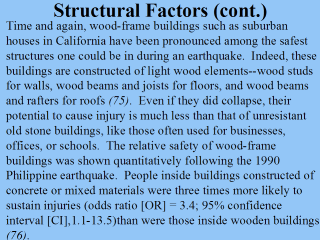| front |1 |2 |3 |4 |5 |6 |7 |8 |9 |10 |11 |12 |13 |14 |15 |16 |17 |18 |19 |20 |21 |22 |23 |24 |25 |26 |27 |28 |29 |30 |31 |32 |review |

|
Another structural risk factor
for death and severe injury in earthquakes is the building height. In the 1988 Armenian
earthquake, people inside buildings with five or more floors were 3.65 times more likely
to be injured compared to those inside buildings less than five floors in height (95% CI,
2.12-6.33) (65), and in the 1990 Philippine earthquake, people inside buildings
with seven or more floors were 34.7 times more likely to be injured (95% CI, 8.1-306.9) (66).
In a high-rise building, escape from upper floors is unlikely before the building
collapses, and if it collapses completely, perhaps 70% of the building's occupants are
likely to be trapped inside (64). On the other hand, in a low-rise building that
takes perhaps 20 or 30 seconds to collapse, more than three-quarters of the building's
occupants may be able to escape before the collapse (64). Damage to other human-engineered structures such as transportation networks (e.g., bridges, roads, and railways) can also pose serious threats to life in earthquakes. For example, in the 1989 Loma Prieta earthquake, 42 of the 62 total deaths resulted from the collapse of the upper section of the Cypress Viaduct of Interstate 880 in Oakland, which trapped motorists driving on the lower section (77). |